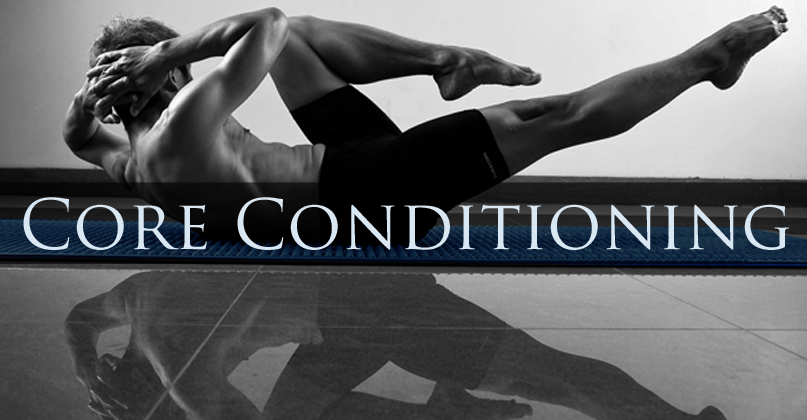
By now we’ve all heard the latest buzzword in fitness – the Core. We know core conditioning is important, and some of us may even have rushed out and bought the revolutionary Swiss ball, or joined a Pilates workout in an attempt to strengthen our core.
Although fitness experts agree that strengthening the core is an effective way of improving posture and reducing back problems, boosting your fitness performance and preventing injury, you also run the risk of muscle imbalance and injury if you do not do the core exercises correctly.
Like any training programme, it’s worth going back to basics to learn more about your core. Unless you have a basic understanding of these muscles and actually put them to the test it’s unlikely that you will get the real core experience.
Think of the core like that of an apple; the core of your body is the section that runs down the middle. The core muscles start at the skull, run through the neck and shoulders and down to the pelvic floor.
The “outer” unit of the muscles includes the rectus abdominus (the muscles that run down the front of the torso and give the six-pack effect), the erector spinae (back) and the gluteus maximus (bottom).
The inner unit or “true core” includes the pelvic floor, diaphragm, deep abdominal and spinal muscles.
When talking “core”, the inner unit is really what you want to target when you’re performing balance exercises such as sitting on a Swiss ball or performing a stability exercise.
The key is knowing how to activate these muscles and not the outer muscles. We often hear an instructor telling us to “draw our navel to our spine” and it’s here that we tend to breathe in and contract our buttocks using the outer unit.
Instead, you should gently contract the pelvic floor and deep abdominals (the transverses), the muscles behind the belly button, or just below it.
When contracting these, you’re breathing out, not in. Instability (for instance using a Swiss ball or wobble board) doesn’t guarantee a core workout either.
Sitting on a Swiss ball won’t instantly activate core muscles and often the strong superficial “outer” core muscles can take over.
These muscles can stabilise the torso without actually engaging the inner unit. And, like any strength training, if you continue to do it wrong, it can result in muscular imbalances and faulty movement patterns.
Even if you’re fit and strong, you may have over-trained the outer unit (for example by doing lots of sit-ups) and find it harder to engage the deeper muscles.
In fact, if we go back to our ancestors it’s highly unlikely they would have hit the deck with a hundred sit-ups. Their core strength would have come from doing daily activities which would have included movements such as pulling (dragging an animal), pushing (moving heavy rocks or animals), lunging, squatting and twisting the torso.
By placing emphasis on the correct breathing and technique during all standing exercises and the movements already mentioned, your inner core will strengthen up.
The way you hold and move your body throughout the day also plays an important part. Sitting at an office desk can create rounded shoulders and tight hip flexors.
Equally, walking around with drooped shoulders and a pot belly can cause imbalances. Therefore it’s important to identify these problems and rectify them first with correct strengthening and stretching exercises before starting core work.
Awesome tips for core awareness:
Find the pelvic floor
The pelvic floor forms the basis of core exercises. Sit on a stability ball and lean forward.
This means the pelvic floor is against something so is easier to feel when you lift and also stops you clenching your buttocks. Now lift and pull up the muscles inside much like a lift going up. Repeat this about 20 times holding at the top for a split second. Do this three to four times a week.
The punch test
Stand up straight with knees slightly bent and place your hands lightly on your ribcage. Imagine a punch to your lower belly, exhale and tense the muscles.
You should feel your transverses abdominus tensing. Repeat this and maintain the tension by pulling in and up, keeping the breathing. This is a great exercise to practise anywhere, anytime.
The Velcro and rod test
This visualisation will help get you in touch with your core. Imagine four strips of Velcro attached to the back of your stomach muscle that runs down the front of the torso. Now Velcro each one to your backbone and run a steel rod through that.
First, this will help you to visualise keeping the abdominals lengthened (by imaging the rod) which will enhance posture. Second, it will help keep them held towards your backbone (by visualising the Velcro strips).
Balance
Once you feel you are in touch with your inner core practice the punch and Velcro/rod test standing on one leg. Keep the standing leg slightly bent and extend the other leg out to the side.
Make sure you do not lean to the left or the right but keep shoulders level. Repeat on both legs and hold for a few seconds.
Everyday activity
Keep your shoulders back and relaxed, Velcro those stomach muscles to your backbone, keep lengthened through the abs (with the rod) and you will have a core for life.
Article contributed by Jenni Rivett from “Getting to the Core”.Visit our website to book into a healthy Pilates session at www.thehhundred.ae (The Hundred Pilates Studio in Dubai)


